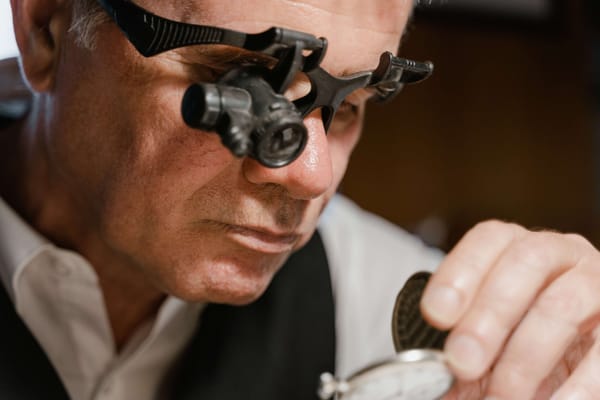The work of the CMO is something that just about every department outside of marketing has opinions on. And this amount of scrutiny makes it an extremely high-pressure C-suite position. Thankfully, Jeff Biesman, Dual CMO for National Debt Relief and Reach Financial, is with us to explain how you can manage that scrutiny and use that pressure to turn coal into diamonds.
Originally an episode of CMO Convo, read on for a full write-up of what we discussed.
Key talking points:
- Jeff’s dual CMO role
- What it means to be under the CMO magnifying glass
- The growing importance of growth
- Navigating other executives’ expectations
- Overcoming the challenges of a hybrid workforce
- What to do when alignment is elusive
Prefer to listen? Check out Jeff's appearance on the CMO Convo podcast 👇
Jeff’s dual CMO role
Thank you for joining us, Jeff. We’re going to be talking about a very interesting topic and one that's on the mind of a lot of CMOs: the CMO magnifying glass and how you operate when you're under so much scrutiny.
But before we get down to that, Jeff, maybe you'd like to introduce yourselves to our audience. Tell us about yourself and why we're speaking to you today.
Absolutely. I’m Jeff Biesman, and I am a dual CMO if there is such a thing. I'm the Chief Marketing Officer for National Debt Relief, which is a debt settlement company. We help a lot of people get out of debt. In fact, over the course of more than 10 years, we've helped hundreds of thousands of people and resolved about $10 billion in debt. It's an amazing service for people that are facing an uphill battle.
I'm also the CMO at Reach Financial, which is a sister company. It’s a fintech that today acts as a personal loan lender, but we aspire to have more products in the future. So I’ve got my hands full in two businesses.
What it means to be under the CMO magnifying glass
Because of the types of businesses you’re involved with, not only are you under a lot of scrutiny internally, you've got a lot of regulations and outside scrutiny to deal with at the same time.
Let's talk about what it means to be operating under the CMO magnifying glass. What does that mean to you, and what do you think it means to CMOs around the world right now?
I think it's more challenging than ever to be a CMO. That’s not a gripe; it is what it is. The charter of a CMO is really broad, and it's evolved significantly. This may sound like, “Water is wet,” but there’s a massive amount of focus on results and revenue.
Every dollar that's invested needs to be accounted for, so a CMO is almost like a proxy for the head of sales or revenue to a large degree. That puts a lot of pressure on the position to deliver results, and not just deliver them on a one-time basis, but continuously. That's probably been the biggest evolution of the seat over the last 25 or 30 years.

The growing importance of growth
And you can’t just keep delivering at the same level; you've got to keep growing as well, which is extra pressure, of course.
It really is. Over the last five-plus years, we’ve seen the emergence of the chief growth officer, but in many ways, I feel the role of CMO has been synonymous with that. A really good CMO is obsessed with growth. All they think about is building a sturdy company that’s capable of growing, not just today, but also into the future.
That's been a major evolution in the role – this maniacal focus on growth, growth, growth. All eyes are on the CMO to deliver those results.
A lot of the time, CMOs don't have the option to focus on long-term growth because they've got to respond to the immediate needs of the company. If they don't respond to the needs of the company, a lot of the time they're out of there – CMOs have the shortest tenure of any C-suite executive. That level of pressure has gotta be huge to deal with.
It is. People joke about changing the wheels on a car when it's going at 80 miles an hour down the freeway, and sometimes that's what you're trying to do. Said a little more operationally, you've got to have a foot in today and deliver results right now while also focusing on strategy and leapfrogging the competition two to five years out.
It's a big balancing act. It's fun, but it requires a significant amount of discipline. If you’re only in the present moment and you're operating within the boundaries, there's only so far you can go. But if a company isn't highly operationally focused on the present moment, you risk not delivering results. You may be trying to build a ship, but you’ve got to be able to navigate with your little canoe and get the best you can out of it.
Navigating other executives’ expectations
Marketing touches so many different parts of the business. You're not just reporting to the CEO; you've got to keep your CRO, your head of product, and the CFO happy too. With all these different demands, you've got to feel stretched. How do you deal with that?
It really does keep you sharp. The conversations that you're having throughout the day can toggle from technology to finance to sales to you name it. The ability to be conversant and speak in currency is incredibly important in the CMO role.
You're constantly shifting gears and needing to have a conversation in the language of the person that you're talking to so it’s meaningful for them. Some would say it’s challenging, some would say difficult, but I say it's fun.
It becomes second nature. I think a lot of CMOs learn by trial and error, and when you're having conversations with folks and you're not speaking their language, you learn quickly that there's a disconnect. If you've got good intuition, you'll know that you don't have alignment.
It's something I talk to my folks about all the time: when you're talking to finance, talk about investments that are driving ROI and profitability – keep it that simple. When you're talking to sales, talk about how you’re going to get them revenue right now and how you’re going to make things easier for sellers. You have to meet your audience where they are.
Put yourself in the CFO’s shoes. They want to hear that I'm going to make the company money and that I'm going to be a responsible steward for investments. That's the conversation that we need to have, and that's sometimes where there's misalignment – we speak about things in terms of how we view them as marketers, without taking other stakeholders’ perspectives into account.
This is a machine, and all the parts of the machine need to all click together. And so, when you're abstracted from those conversations, you're not as effective. So I try to get the entire marketing department to understand what's important to finance, what's important to sales, what's important to product, technology, and anybody else in the organization. We're all stewards of what we're trying to get done, and I think we're more effective because of that.

Overcoming the challenges of a hybrid workforce
That cohesive view of the business world made sense when most companies were operating in one location. How do you ensure company alignment in a world of hybrid and remote work, when you've got teams that are even separated by continents?
It’s challenging. I wish I could say that I've cracked the code on how to make it work, but marketing is a function where people benefit from being together in the same room. You get more creativity, and you just get more done that way, I think.
There are two or three things that we're doing now that are necessary for us to be successful. One is over-communicating. You’ve got to do it, and so your meeting schedule is packed – mine is, more than ever. It’s just back to back. You don't have that benefit of the watercooler conversation, so you've got to schedule time to get everybody up to speed.
Secondarily, if at all possible, you cannot work in a 100% remote culture. In the long run, it’s going to negatively impact the business. People don’t feel connected; they feel like they're on an island, and it's very, very difficult.
You almost have to force in-person meetings. We're working on a cadence where three to four times a year, we get our marketing folks together. We're all in the US, which is great, but we’re across all time zones. However, we don’t have to force the issue of meeting in person because I think people are craving it.
If you're not thinking about that already, I'd suggest that you take a look at getting your marketing team or any other team in a company together with some frequency.
There are times I've made the choice to fly across the country to be in a room with folks. It's easy to say, “I'll just do it on video,” but the impact is so much greater when you do it face to face. You can't do it for every meeting, but I will make that choice when necessary, and I'll encourage my folks to make that choice too.
Some people are a little gun-shy around travel and expenses, but I think the good so outweighs the bad. You can really circle the important issues when you’re physically there, and you miss a lot when you just dial in. Even the little things like the nuance of crosstalk and body language are very difficult to gauge over a video call and a lot easier to manage when you're in a room with people.

What to do when alignment is elusive
So, Jeff, we've talked a bit about best practices when it comes to finding alignment, but best practices can only take you so far. If you’re in a situation where you know that alignment is impossible, what should you do? Do you walk away from the company? Do you go over people’s heads to the CEO?
I’ll tell you straight up, you don't walk away from a company. I mean, I'm not saying never walk away – there may be a situation where nothing can be resolved. Most of the time though, the answer is not to walk away. The answer is not to go above your peers, either. If you do that, you're failing at what you need to do, which is to get alignment.
Now, you may not always get complete agreement, and that’s fine. I actually think that's healthy.
As an example, my chief sales officer and I have a wonderful relationship, but we have both openly talked about the idea that there ought to be a healthy tension between us. Not discord, not disagreement, but if we're not totally aligned on everything, that's okay.
My counterpart may say, “I don't agree with that,” but you have to have your conviction. You have to do what you can in the best interests of the business and realize that sometimes people see it a little bit differently. You don't want to have complete discord – then you have real problems – but it's okay to have a little bit of tension and disagreement.
I would argue that when you're not challenged, when there isn’t tension, and when you're not doing something you've never done before, you're not developing and growing. That's not in your best interest, and it's not in the company's best interest. So it’s important to be able to constantly challenge yourself and challenge your peers and have those hard conversations.
It pushes you to be more creative as well. If you're just keeping the wheels greased and keeping the machine moving, you're not improving the machine. You're not exploring new avenues and options that could make the machine run more efficiently or go faster.
Yeah, and when you're not doing that, you might want to have a conversation with yourself about whether it's time to move on. The charter of a modern CMO is all about growth. And growth is not about just continuing to do the same thing over and over again.
Also, growth is not linear. The mistake a lot of people make is to see growth as a linear path from X to Y. It never happens like that, and so if you're not constantly innovating and pushing, then you're going to top out. And if that's what you want, and you're like, “I don't really feel it,” then it's not the right job for you anymore.
You have to be courageous, and it's a really difficult thing for some folks. I’m not that guy that's going to go poke at my peers or look under every rock to find everything that's wrong. I don't do that, but you do have to be able to say, “Hey, I think we could do better here,” or, “I don't think that this is good enough,” in a way that is healthy and respectful.
We've talked a little bit about the CMO role and scrutiny. Scrutiny isn't always great, it's not fun, but you have to realize where it's coming from. It's also important that you're able to deliver that message without it looking like you're trying to submarine somebody. That’s something you’ve got to remind yourself of as a CMO and just remember how to do it and do it tactfully.
Do it tactfully, absolutely. That also goes back to what we were talking about earlier: being able to communicate in a way that is understandable to the person you’re talking to. If you're able to communicate ways to improve sales in a language that sales understands and respects, that is going to be taken on board.
They're going to trust that advice more because it's not going to come across as someone who doesn't know what they're talking about saying, “Oh, we need to fix this.” You're showing ways things can be improved practically.
Absolutely. And there are subtle things you can do to make sure that people see you as an ally and an advocate. It’s gonna sound silly, but if you're in a meeting with a counterpart or a peer, sitting on the same side of the table as them shows that you are literally and figuratively on their side. These nonverbal cues give somebody an understanding that you're here to help.
And I've been in situations where it's the exact opposite. You walk into a room, and other the C-suite execs are sitting across from you with their arms folded. My first feeling when that happens is, “Aren't we on the same team, guys?” We're all here to do the same thing and help our organization win.
So I think it's incredibly important that you have that level of trust and you're constantly reinforcing that you're just here to help.
That's a really good note to wrap things up with there, Jeff, because that is ultimately what the CMO’s role is: to help all the other parts of the business succeed.
There's no question about it. I think it's an incredibly fascinating and fulfilling job. And while we’ve talked about the constant critique and pressure, it comes with the territory. When I hear others complaining about it, I'm like, “This is what you signed up for. If you don't like what comes along with it, do something else.”
I know that sounds trite, but I mean it. You're gonna get the critique. Everybody's gonna come tell you what they don't like about the website or the latest marketing campaign, even if they don’t have all the information. Being defensive and combative is never gonna work in your favor, so just accept it for what it is. Embrace it and speak in that language that really resonates with your audience.
We normally round things out with a golden rule to tie everything together, but that's it right there. We've had the golden rule, so thank you very much.
It's been great speaking to you today. It’s been a great conversation and one that's gonna be relevant to pretty much every marketer out there, no matter what level you're at.
It's been wonderful. I really appreciate it.
How are you handling the scrutiny? Need advice on how to use that pressure to turn coal into diamonds? Join the conversation with a global network of CMOs and marketing leaders on the CMO Alliance Community Slack channel!




 Follow us on LinkedIn
Follow us on LinkedIn




